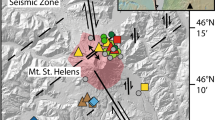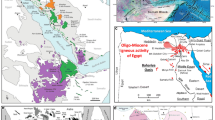Abstract
Mount Etna volcano erupted almost simultaneously on its northeastern and southern flanks between October 27 and November 3, 2002. The eruption on the northeastern flank lasted for 8 days, while on the southern flank it continued for 3 months. The northeastern flank eruption was characterized by the opening of a long eruptive fracture system between 2,900 and 1,900 m.a.s.l. A detailed survey indicates that the fractures’ direction shifted during the opening from N10W (at the NE Crater, 2,900 m) to N45E (at its lowest portion, 1,900 m) and that distinct magma groups were erupted at distinct fracture segments. Based on their petrological features, three distinct groups of rocks have been identified. The first group, high-potassium porphyritic (HKP), is made up of porphyritic lavas with a Porphyritic Index (P.I.) of 20–32 and K2O content higher than 2 wt%. The second group is represented by lavas and tephra with low modal phenocryst abundance (P.I. < 20) named here oligo-phyric (low-phyric), and K2O content higher than 2 wt% (HKO, high-potassium oligophyric). The third group, low-potassium oligophyric (LKO), consists of tephra with oligophyric texture (P.I. < 20) but K2O content < 2 wt%. K-rich magmas (HKP and HKO) are similar to the magma erupted on the southern flank, and geochemical variations within these groups can be accounted for by a variable degree of fractionation from a single parent magma. The K-poor magma (LKO), erupted only in the upper segment of the fracture, cannot be placed on the same liquid line of descent of the HK groups, and it is similar to the magmas that fed the activity of Etna volcano prior to the eruption of 1971. This is the first time since then that a magma of this composition has been documented at Mt. Etna, thus providing a strong indication for the existence of distinct batches of magma whose rise and differentiation are independent from the main conduit system. The evolution of this eruption provides evidence that the NE Rift plays a very active role in the activity of Mt. Etna volcano, and that its extensional tectonics allows the intrusion and residence of magma bodies at various depths, which can therefore differentiate independently from the main open conduit system.








Similar content being viewed by others
References
Andronico D, Branca S, Calvari S, Burton MR, Caltabiano T, Corsaro RA, Del Carlo P, Garfì G, Lodato L, Miraglia L, Murè F, Neri M, Pecora E, Pompilio M, Salerno G, Spampinato L (2005) A multidisciplinary study of the 2002–03 Etna eruption: insights for into a complex plumbing system. Bull Volcanol 67:314–330
Armienti P, Pareschi MT, Innocenti F, Pompilio M (1994) Effects of magma storage and ascent on the kinetics of crystal growth. Contrib Mineral Petrol 115:402–414
Armienti P, Tonarini S, D’Orazio M, Innocenti F (2002) Genesis and evolution of Mt. Etna alkaline lavas: petrological and Sr-Nd-B isotope constraints. Per Mineral 73:29–52
Azzaro R (1999) Earthquake surface faulting at Mount Etna volcano (Sicily) and implications for active tectonics. J Geodynam 28:193–213
Barberi F, Brondi F, Carapezza ML, Cavarra L, Murgia C (2003) Earthen barriers to control lava flows in the 2001 eruption of Mt. Etna. J Volcanol Geotherm Res 123:231–243
Barbieri M, Cristofolini R, Delitala MC, Fornaseri M, Romano R, Taddeucci A, Tolomeo L (1993) Geochemical and Sr-isotope data on historic lavas of Mount Etna. J Volcanol Geotherm Res 56:57–69
Burton M, Neri M, Andronico D, Branca S, Caltabiano T, Calvari S, Corsaro RA, Del Carlo P, Lanzafame G, Lodato L, Miraglia L, Salerno G, Spampinato L (2005) Etna 2004–2005: an archetype for geodynamically controlled effusive eruption. Geophys Res Lett 32:LO9303. doi:10.1029/2005GL022527
Clocchiatti R, Condomines M, Guènot N, Tanguy JC (2004) Magma changes at Mount Etna: the 2001 and 2002–2003 eruptions. Earth Planet Sci Lett 226:397–414
Corsaro RA, Pompilio M (2004) Buoyancy-controlled eruption of magmas at Mt. Etna. Terra Nova 16:16–22
Corsaro RA, Miraglia L, Pompilio M (2007) Petrologic evidence of a complex plumbing system feeding the July-August 2001 eruption of Mt. Etna, Sicily, Italy. Bull Volcanol 69:401–421
Couch S, Harford CL, Sparks RSJ, Carroll MR (2003a) Experimental constraints on the conditions of formation of highly calcic plagioclase microlites at the Soufriere Hills Volcano, Montserrat. J Petrol. 44:1455–1475
Couch S, Sparks RSJ, Carroll MR (2003b) The kinetics of degassing-induced crystallization at Soufriere Hills Volcano, Montserrat. J Petrol 44:1477–1502
Cristofolini R, Romano R (1982) Petrological features of Etnean volcanic rocks. Mem Soc Geol Ital 23:99–115
Cristofolini R, Corsaro RA, Ferlito C (1991) Variazioni petrochimiche nella successione etnea: un riesame in base a nuovi dati da campioni di superficie e da sondaggi. Acta Vulcanol 1:25–37
Ferlito C, Viccaro M, Cristofolini R (2008) Volatile-induced magma differentiation in the plumbing system of Mt. Etna volcano (Italy): evidence from glass in tephra of the 2001 eruption. Bull Vulcanol 70:455–473
Gambino S (2006) High-precision locations of LP events on Mt. Etna: reconstruction of fluid-filled volume. Stud Geoph Geod 4:663–674
Garduno VH, Neri M, Pasquarè G, Borgia A, Tibaldi A (1997) Geology of the NE-Rift of Mount Etna (Sicily, Italy). Acta Vulcanol 9:91–100
Giammanco S, Guerrieri S, Valenza M (1997) Soil CO2 degassing along tectonic structures of Mount Etna (Sicily): the Pernicana fault. Appl Geochem 12:429–436
Gillot PY, Kieffer G, Romano R (1994) The evolution of Mount Etna in the light of potassium-argon dating. Acta Vulcanol 5:81–87
Higgins MD, Roberge J (2003) Crystal size distribution of plagioclase and amphibole from Soufriere Hills Volcano, Montserrat: evidence for dynamic crystallization-textural coarsening cycles. J Petrol 44:1401–1411
Holloway J, Burnham C (1972) Melting relations of basalt with equilibrium water pressure less than total pressure. J Petrol 13:1–29
Huppert HE, Woods AW (2002) The role of volatiles in magma chamber dynamics. Nature 420:493–495
Kieffer G (1975) Pillows and hyaloclastites associated to subaerial lavas at the southwest of the base of Mount Etna (Sicily, Italy). Geol Mediter 77:179–184
Lachance GR, Traill JR (1966) Practical solution to the matrix problem in X-ray analysis. Canad Spett 11:43–48
Le Maitre R (2002) Igneous rocks: a classification and glossary of terms. Cambridge Univ Press, Cambridge
Lentini F, Grasso M, Carbone S (1987) Introduzione alla geologia della Sicilia. In “Introduzione alla geologia della Sicilia e guida all’escursione, Sistemi Avanfossa-Avanpaese lungo la catena Appennino Magrebide”, Meet Soc Geol Ital, Naxos, pp 1–38
Métrich N, Rutherford MJ (1998) Low-pressure crystallization paths of H2O-saturated basaltic-hawaiitic melts from Mt Etna: implications for open-system degassing of basaltic volcanoes. Geochim Cosmochim Acta 62:1195–1205
Métrich N, Allard P, Spilliaert N, Andronico D, Burton M (2004) 2001 flank eruption of the alkali- and volatile-rich primitive basalt responsible for Mount Etna’s evolution in the last three decades. Earth Planet Sci Lett 228:1–17
Monaco C, Tapponier P, Tortorici L, Gillot PY (1997) Late Quaternary slips rates on the Acireale-Piedimonte normal faults and tectonic origin of Mt. Etna (Sicily). Earth Planet Sci Lett 147:125–139
Monaco C, Catalano S, Cocina O, De Guidi G, Ferlito C, Gresta S, Musumeci C, Tortorici L (2005) Tectonic control on the eruptive dynamics at Mt. Etna Volcano (Sicily) during the 2001 and 2002–2003 eruptions. J Volcanol Geotherm Res 144:211–233
Morimoto N (1988) Nomenclature of pyroxenes. Am Mineral 73:1123–1133
Patanè D, Barberi G, Cocina O, De Gori P, Chiarabba C (2006) Time-resolved seismic tomography detects magma intrusions at Mount Etna. Science 313:821–823
Rasà R, Azzaro R, Leonardi O (1996) Aseismic creep on faults and flank instability at Mount Etna volcano, Sicily. In: McGuire WJ, Jones AP, Neuberg J (eds) Volcano instability on the Earth and other planets. Geol Soc London Spec Publ 110:179–192
Romano R (1982) Succession of the volcanic activity in the Etnean area. Mem Soc Geol Ital 23:28–48
Romano R, Guest JE (1979) Volcanic geology of the summit and northern flank of Mount Etna, Sicily. Boll Soc Geol Ital 98:189–215
Romano R, Sturiale C, Lentini F (1982) Geological map of Mt. Etna. In: Romano R. (ed) “Mount Etna volcano: a review of recent earth sciences studies”. Mem Soc Geol Ital 23
Schiano P, Clocchiatti R, Ottolini L, Busà T (2001) Transition of Mount Etna lavas from a mantle-plume to an island-arc magmatic source. Nature 412:900–904
Sisson TW, Grove TL (1993) Experimental investigations of the role of H2O in calc-alkaline differentiation and subduction zone magmatism. Contrib Mineral Petrol 113:143–166
Sun SS, McDonough WF (1989) Chemical and isotopic systematics of oceanic basalts: implications for mantle composition and processes. In: Saunders A, Norry MJ (eds), Magmatism in the ocean basins. Geol Soc London Spec Publ 42:313–345
Tanguy JC, Condomines M, Kieffer G (1997) Evolution of Mount Etna magma: constraints on the present feeding system and eruptive mechanism. J Volcanol Geotherm Res 75:221–250
Thornber CR, Heliker C, Sherrod DR, Kauahikaua JP, Miklius A, Okubo PG, Trusdell FA, Budahn JR, Ridley WI, Mecker GP (2003) Kilauea East Rift zone magmatism: an episode 54 prospective. J Petrol 44:1529–1559
Tibaldi A, Groppelli G (2002) Volcano-tectonic activity along structures of the unstable NE flank of Mt. Etna (Italy) and their possible origin. J Volcanol Geotherm Res 115:277–302
Viccaro M, Ferlito C, Cortesogno L, Cristofolini R, Gaggero L (2006) Magma mixing during the 2001 event at Mt. Etna (Italy): effects on the eruptive dynamics. J Volcanol Geotherm Res 149:139–159
Wezel FC (1967) I terreni quaternari del substrato dell’Etna. Atti Acc Gioenia Sci Nat Catania 6, 18:279–293
Yoder HS (1965) Diopside-anorthite-water at five and ten kilobars and its bearing on explosive volcanism. Carnegie Inst Wash Yearb 64:82–89
Acknowledgments
The authors are deeply indebted to T. Wright for his constructive review and for improving the first draft of this paper. Dr. S. Nakada is also greatly acknowledged for his in-depth evaluation of the structure and the logic of the submitted manus. An anonymous referee is also thanked for his useful suggestions. This paper has benefited greatly from all their criticisms. Raul Carampin is thanked for his continuous assistance during EMP analyses at CNR-IGG of Padova. Biagio Ragonese is also thanked for the information he provided on the chronology of the various eruptive events.
Author information
Authors and Affiliations
Corresponding author
Additional information
Editorial responsibility: S. Nakada
Rights and permissions
About this article
Cite this article
Ferlito, C., Coltorti, M., Cristofolini, R. et al. The contemporaneous emission of low-K and high-K trachybasalts and the role of the NE Rift during the 2002 eruptive event, Mt. Etna, Italy. Bull Volcanol 71, 575–587 (2009). https://doi.org/10.1007/s00445-008-0243-9
Received:
Accepted:
Published:
Issue Date:
DOI: https://doi.org/10.1007/s00445-008-0243-9




